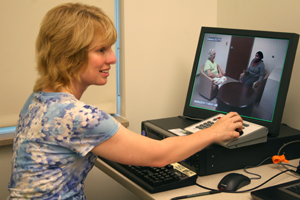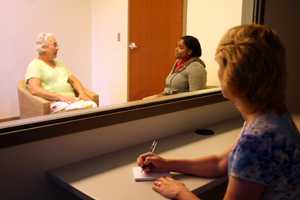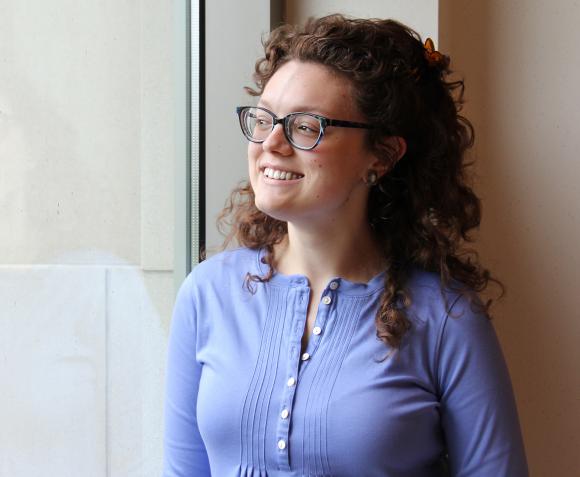Fight or Flight

Pittman observes an interview in the lab.
Psychology Professor Catherine M. Pittman, PhD, HSSP, carefully engineered her undergraduate studies to avoid working with rats. So how did her research on fear and anxiety in humans lead her straight to “rat running”? “It turns out that when we’re afraid, people function no differently from…well, rats,” she says.
Pittman, whose areas of scholarship include neuropsychology and brain injury, has studied the brain functioning underlying fear and anxiety for more than 20 years.
In graduate school, she indeed became a rat runner in order to understand fear responses, which begin in a part of the brain called the amygdala, almond-shaped groups of nuclei located deep within the medial temporal lobes of the brain, and part of the brain’s limbic system.
According to Pittman, humans respond in one of three ways when faced with a situation that inspires fear or anxiety: we freeze up (like “a deer in headlights”), prepare to run, to fight, or to flee from whatever’s confronting us (the well-known fight or flight response).
When the amygdala takes charge to produce these responses, it also overrides higher brain functions, like logical thought, which take place in the cerebral cortex at the top front of the brain, leaving the amygdala in charge of the situation.
It’s the same process that takes place in the brain of rats when they’re under duress.
 Pittman explains the whole process in her new book, co-written with librarian Lisa M. Karle, MLIS, Extinguishing Anxiety: Whole Brain Strategies to Relieve Fear and Stress (Foliadeux Press 2009).
Pittman explains the whole process in her new book, co-written with librarian Lisa M. Karle, MLIS, Extinguishing Anxiety: Whole Brain Strategies to Relieve Fear and Stress (Foliadeux Press 2009).
The book outlines fear responses, how they happen physiologically, and offers strategies for overcoming those that affect peoples’ quality of life. (Learn more.)
Her students are certainly thankful that Pittman understands their anxieties when they step into the lab in her clinical psychology course. In addition to classroom discussion, students use lab space in the psychology suite in Spes Unica Hall where they can demonstrate interviewing techniques they’ve learned in class. While a student interviews a “client”—a fellow student—the rest of the class observes and videotapes their performance through a mirrored window.
Pittman says even though the situation is anxiety-producing, this technology provides Saint Mary’s students with an opportunity for feedback that most psychology students only receive at the graduate level. “There’s nothing like the actual experience of being placed in the therapy situation to help them understand what it’s like,” she says. In the lab, students get to try out being a therapist, which helps them to learn the skills they need to pursue a career in a helping profession, as well as learn about themselves.
“Some find they are not as comfortable with the helper role as they thought, or that the therapy process is slower paced than they’d like. Many students want to become therapists because they can’t stand to see people suffer. Then they discover they’re exposed to that suffering day in and day out,” says Pittman. It’s her job to help students reflect on their experiences and decide whether clinical practice is right for them. That includes being able to cope with anxiety—their own and others’.
Luckily, their teacher is a practicing therapist and can offer her insights on the profession. Pittman practices therapy at Intrigue Counseling in downtown South Bend, Ind. “In my opinion, if you’re going to teach clinical psychology, you’d better be out there practicing,” she says.
Pittman also supervises student internships in the community and in addition to teaching clinical psychology, she teaches courses on abnormal psychology and personality theories.
She chose to pursue a position in higher education after earning her PhD in clinical psychology from Northern Illinois University in DeKalb, and a year-long internship at a Veterans hospital in Detroit, Mich. At the hospital she learned a lot about Post Traumatic Stress Disorder (PTSD), another anxiety-based disorder.
Pittman has taught at Saint Mary’s for 20 years now and the reason she decided to teach still stands. ”Humans are the most fascinating things to study and I want to be at a place where I can study and talk about them,” she says. Twenty years later, she’s still fascinated.

